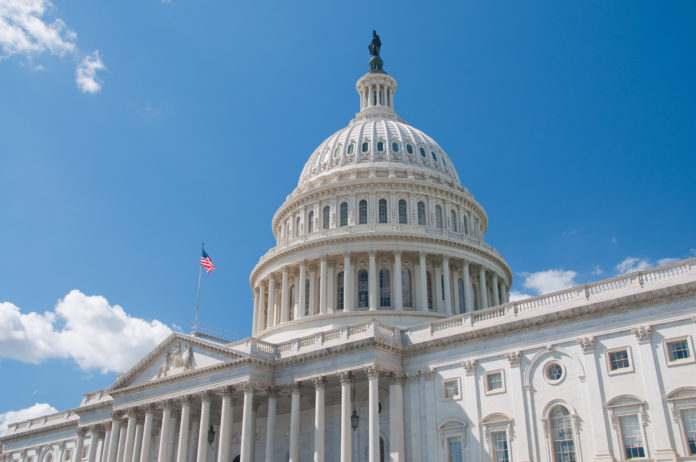Select each title below to read more:
Budget Reconciliation Bill Passes the Senate
On July 1, the Senate passed its version of the budget reconciliation bill which is formally titled “An act to provide for reconciliation pursuant to title II of H.Con.Res.14” but will be referred to as the One Big Beautiful Bill Act. The final vote was 51-50 with Vice President J.D. Vance breaking the tie. Senators Rand Paul (R-KY), Susan Collins (R-ME), and Thom Tillis (R-NC) voted no along with all Democrats. This vote came after over 24 hours of vote-a-rama — a process through which amendments to the bill are offered. The length of this process was due in part to Senate Republicans continuing to negotiate throughout June 30 and overnight and into the morning of July 1 on the substance of the bill to secure votes. The House Rules Committee is considering the rule on the bill on July 1 and the House hopes to vote late on July 1 or July 2. This could slip depending on the House’s ability to secure the votes that they need. LeadingAge has updated our action alert to be directed to urge House members to oppose the bill; please take action here.
Much of the bill remains the same as reported in this article. Changes include:
- The artificial intelligence provision was removed dramatically; 99 Senators ended up opposing the provision.
- The rural transformation fund was appropriated $50 billion, up from $25 billion in the previous version of the bill.
- The nursing home staffing mandate is under moratorium until 2034. There were some technical corrections to make it compliant with the Parliamentarian’s ruling.
- The provisions that would have raised the FMAP for Alaska and Hawaii were removed along with the provisions that would have reduced the FMAP for states that cover undocumented immigrants and gender affirming care were also removed.
- The provider tax provision remained the same as the June 28 version of the bill (the article above describes this in more detail).
LeadingAge opposes this bill and we are urging House members to vote no.
Senate Tax Policy Proposals Impacting Nonprofits Remain Unchanged in Final Bill
On July 1, the U.S. Senate voted to pass its version of the One Big Beautiful Bill Act, and the House of Representatives has immediately begun consideration of the Senate bill. On June 17, we posted this article summarizing the first version of the Senate’s legislative language relating to certain tax issues affecting nonprofits and this bulletin on housing credit changes. A second version of the Senate bill released June 28 did not alter the policies and language covered by our June 17 reporting, and the final language the Senate has now approved does not alter it, either. LeadingAge will post an updated summary of tax issues as soon as possible; until then, our prior article and bulletin accurately describe the Senate position. Follow all related information via our Budget Reconciliation 2025 serial post.
Impact Analysis of Medicaid Cuts on Nursing Homes Released by Top Senators
Senate Finance Committee Ranking Member Ron Wyden (D-OR), Finance Committee member Senator Mark Warner (D-VA), Senate Budget Committee Ranking Member Jeff Merkley (D-OR), and Senate Minority Leader Chuck Schumer (D-NY) released a June 27 analysis regarding the potential impacts on nursing homes of Medicaid cuts contained in H.R. 1, the One Big Beautiful Bill Act. The analysis, conducted by researchers from the Brown University School of Public Health, identifies 579 nursing homes across 45 states that would be at elevated risk of closure due to the more than $800 billion in proposed Medicaid cuts. The states with the highest numbers of at-risk facilities are Illinois (93), Texas (66), Ohio (41), Missouri (39), and Georgia (37).
The analysis examines 10 years of nursing home data to determine the top indicators of financial risk for nursing home closures: facilities that have the highest levels of residents enrolled in Medicaid (85% or more), facilities with the lowest occupancy rates (less than 80%), and those with the lowest quality ratings (a 1- or 2-star quality rating). The full analysis can be found here. A list of the 579 nursing homes at an elevated risk of closure is here. The letter requesting the analysis can be found here.
CMS Updates PBJ Manual and FAQs
The Centers for Medicare & Medicaid Services (CMS) has issued an update to payroll-based journal (PBJ) materials on the Staffing Data Submission Payroll Based Journal webpage. Updates to the PBJ Policy Manual include info for PBJ system registration through QIES and clarification that all reported nursing hours must be onsite hours. Updates to the PBJ Policy Manual FAQs reiterate the updates in the policy manual, and also include clarifications related to meal breaks, salaries staff, RN hours requirements and waivers, and questions pertaining to PBJ audits. Check out these updates in the PBJ Policy Manual and the PBJ Policy Manual FAQs located in the Downloads section of the PBJ page on the CMS website.
A Busy Day for OSHA: Agency Announces Two Proposed Rules and One Withdrawal
On June 30, the Occupational Safety & Health Administration (OSHA) released two new proposed rules for public inspection and issued a notice that it is withdrawing a previously released proposal. First: OSHA is proposing to remove OSHA’s COVID-19 Emergency Temporary Standard and its associated recordkeeping and reporting provisions from the Code of Federal Regulations. This proposal is not a surprise, because the agency in early 2025 notified the public that it would no longer seek to create a permanent COVID-related standard. We are still watching to see if OSHA will propose a rule with changes to infectious diseases standards more broadly, as the Biden administration had planned to do.
Second: OSHA is proposing to remove from its respiratory protection standard the medical evaluation requirements for filtering facepiece respirators and loose-fitting powered air-purifying respirators. OSHA publishes semi-annual regulatory agendas, and we have not seen this issue called out in recent versions of those documents.
Third: OSHA is withdrawing a long-pending proposal, dating back at least to 2010, to amend the OSHA 300 Log by adding a column that employers would use to record work-related musculoskeletal disorders. Withdrawal of the proposal does not change any employer’s obligation to complete and retain occupational injury and illness records under OSHA’s existing regulations. LeadingAge will analyze the two newly proposed rules and provide additional information.
CMS Releases Yet Another Devastating Home Health Proposed Rule
On June 30, the Centers for Medicare and Medicaid Services released the CY2026 Home Health Proposed Rule that will make an aggregate -6.4% cut to the base payment. CMS is proposing a -4.059 percent permanent adjustment to the CY2026 home health base payment rate. Additionally, the temporary adjustment which has been accruing over the last several years now stands at $5.3 billion. If this were to be taken back in a single year it would be a 35% reduction to the base payment, which CMS considers too much of a burden. Therefore, CMS is proposing to apply the first temporary adjustment in CY2026 with an additional -5.0 percent on top of the proposed -4.059 permanent adjustment. The minuscule market basket update for CY2026 is proposed at only 3.2 percent. The estimated aggregate decrease is -6.4% or -$1.135 billion. Coupled with the -8.79% cut to the baseline since CY2023, if this rule goes into effect, LeadingAge believes this will threaten the very existence of nonprofit, mission driven home health Between 2019 and 2023, the number of skilled home health agencies that treated more than 10 fee-for-service patients annually decreased or remained the same in 94.1% of U.S. counties. These are concerning statistics considering the growth in the older adult population and the focus on receiving care in the home. In addition to the devastating cuts, the rule includes removal of several measures in the home health quality reporting program, Home Health Value Based Purchasing quality measure set, and changes to the Conditions of Participation regarding all-payer OASIS collection. LeadingAge will be working on a full analysis of the rule and will share more at the July 1 Home Health Network meeting.
Weekly Recaps: July 2, 2025
Here is your Hospice Weekly Recap.
Here is your Life Plan Community Recap.
Here is your Medicaid, HCBS, and PACE Weekly Recap.
Here is your Nursing Home Weekly Recap.
Here is your Home Health Weekly Recap.
Here is your Affordable Housing Weekly Recap.





